Entries in wind farm easement (12)
9/6/10 What to expect when you're expecting wind farm construction
What should you know before you lease your land to a wind developer?
You should know you must consult an independent lawyer BEFORE YOU SIGN. You will need someone who can tell you how the contract says the lease holder can use your land before, during and after construction.
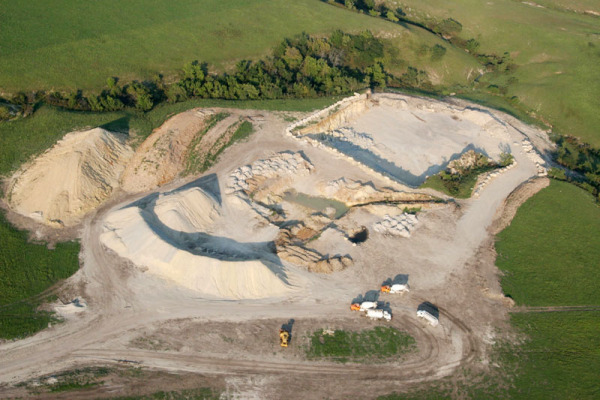
This picture shows the construction of a wind turbine project in Kansas.
Let's look closer..... 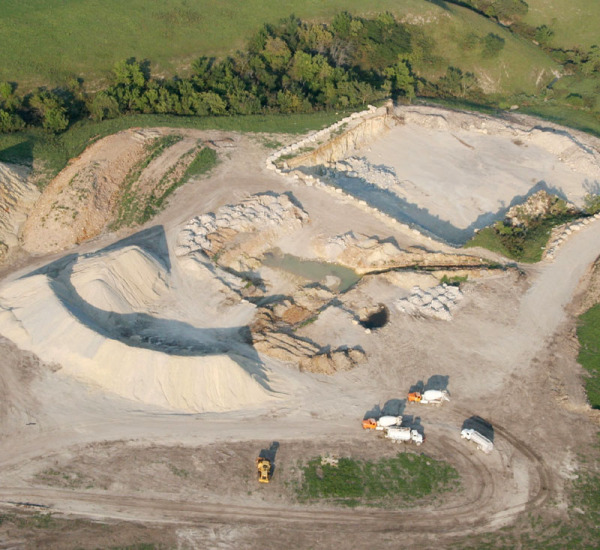
You should know how much of your land will be used during the construction phase and for how long, if you have any say at all in where the turbines will be sited, where the cables will be laid, and where the access roads will go. Only an independent lawyer can tell you what the contract says about this.
Look closer-
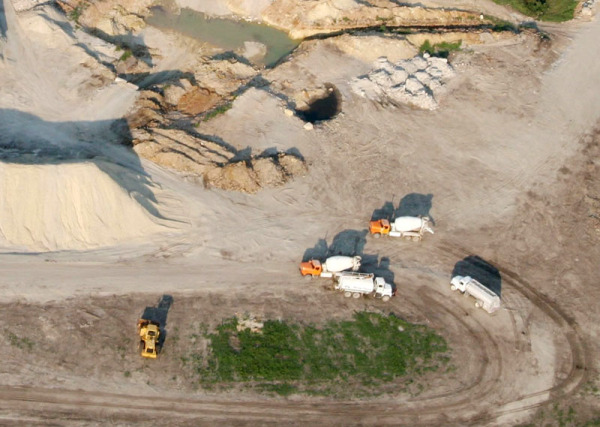
You should know that contracts may give the lease holder the right to go over, under, upon, along, and across your land, 24 hours a day, 7 days a week for the next 20 to 30 years. You should know what your rights are if changes, disputes or problems arise, and by what means problems may be resolved. An independent lawyer can tell you this.
Look closer..
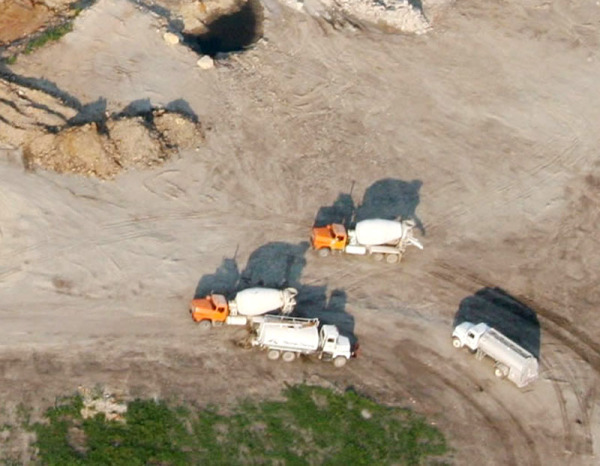
You should know that most lease agreements will be legally binding not just to you, but to your kids, any heirs, any future buyers, successors, executors, or assignees of any kind. You should know that most lease agreements require that ANYONE who owns the land after you or wishes to buy the land from you, will be also legally bound by the terms of this contract. Only an independent lawyer can tell you exactly what this means to the future of your property.

(To see more of this series of construction photos taken in Kansas, click here.)
9/1/10 Sow the wind turbine, reap the crop damage AND...Wind Action Asks the hard Question: How compatible are wind farms and agriculture? AND Wind Turbines in the News AND A new understanding about wind turbine noise AND A letter from a participating wind project landowner from Columbia County to landowners in Brown County
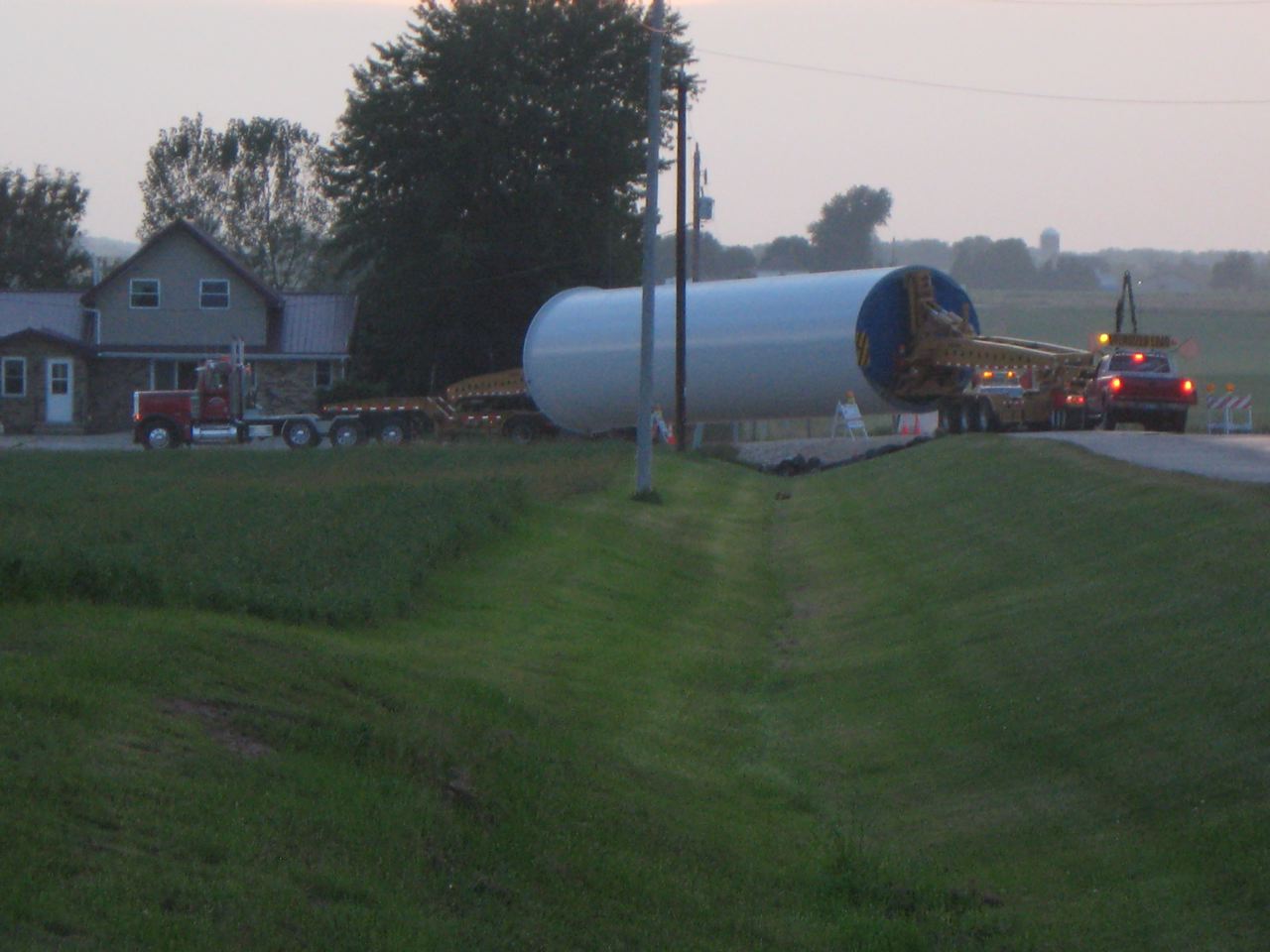
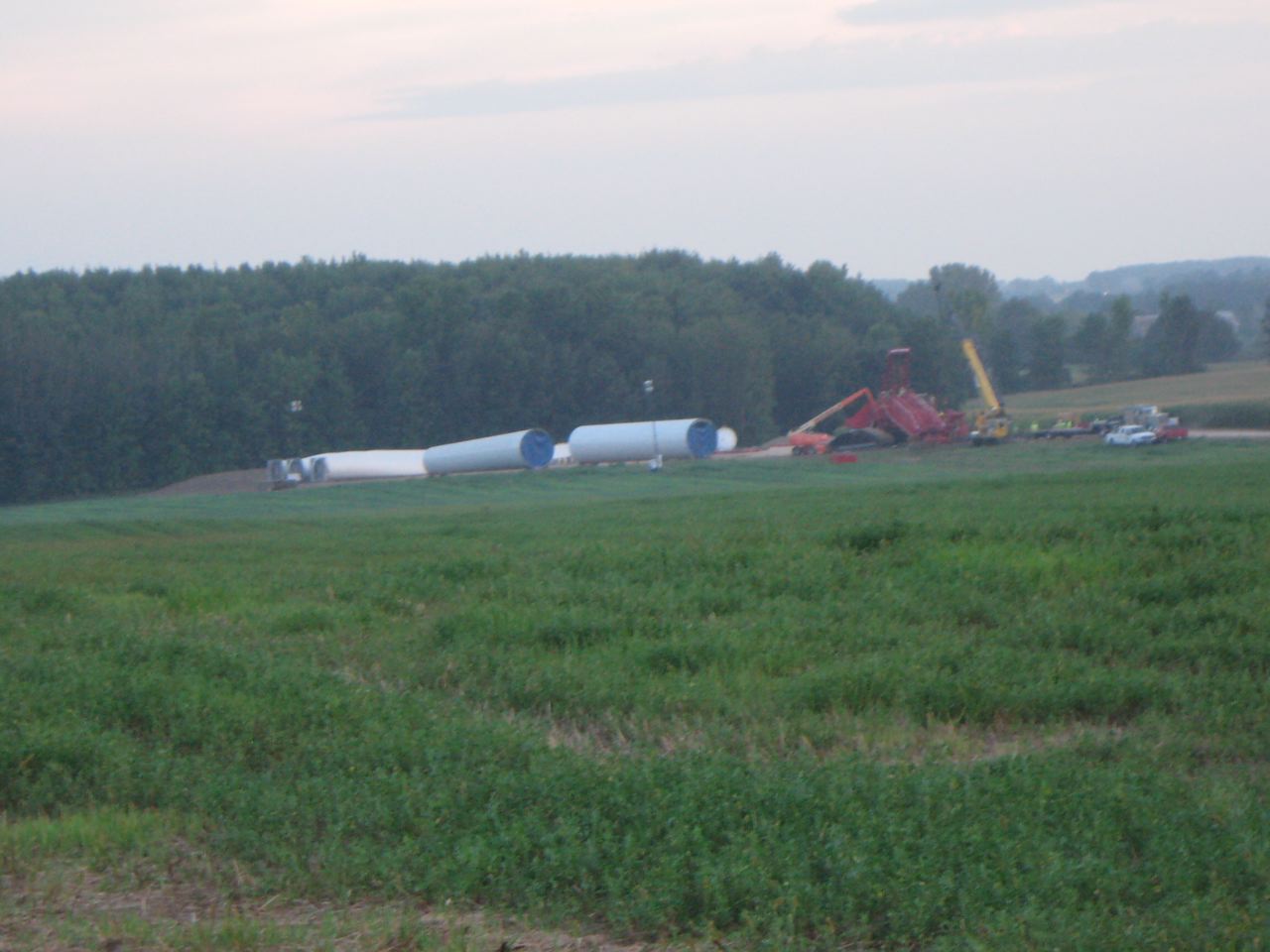 Construction begins on what will be the tallest wind turbines in the state. Town of Glenmore, Brown County Wisconsin. More photos throughout this post.
Construction begins on what will be the tallest wind turbines in the state. Town of Glenmore, Brown County Wisconsin. More photos throughout this post.
Below is A letter from a participating landowner in the Glacier Hills project which is under construction in Columbia County. He address it to Brown County landowners in an area where Invenergy wants to site a large project called "Ledge Wind"
SOURCE: PSC Docket # 9554-CE-100
To the landowners in the Ledge Wind Project:
If you believe wind turbines are a good fit for a farm operation, a free source of clean energy, and a benefit to your community, I invite you to come to the Glacier Hills Project and witness the total devastation occuring during construction.
Seeing firsthand what is happening here would turn any responsible landowner's stomach.
Heavy rains have created erosion that will take years to repair.
The number of huge construction equipment and trucks burning fuel is staggering.
Good productive farmland is being ripped apart, and will never be the same.
The level of disgust is even affecting the most loyal supporters of this project.
Hatred of this project is growing worse as each day passes, and we will be forced to live with this for the rest of our lives, all because a few irresponsible landowners, myself included, were taken in by wind developers lies.
All this for chump change.
Gary Steinich
Cambria, Wisconsin
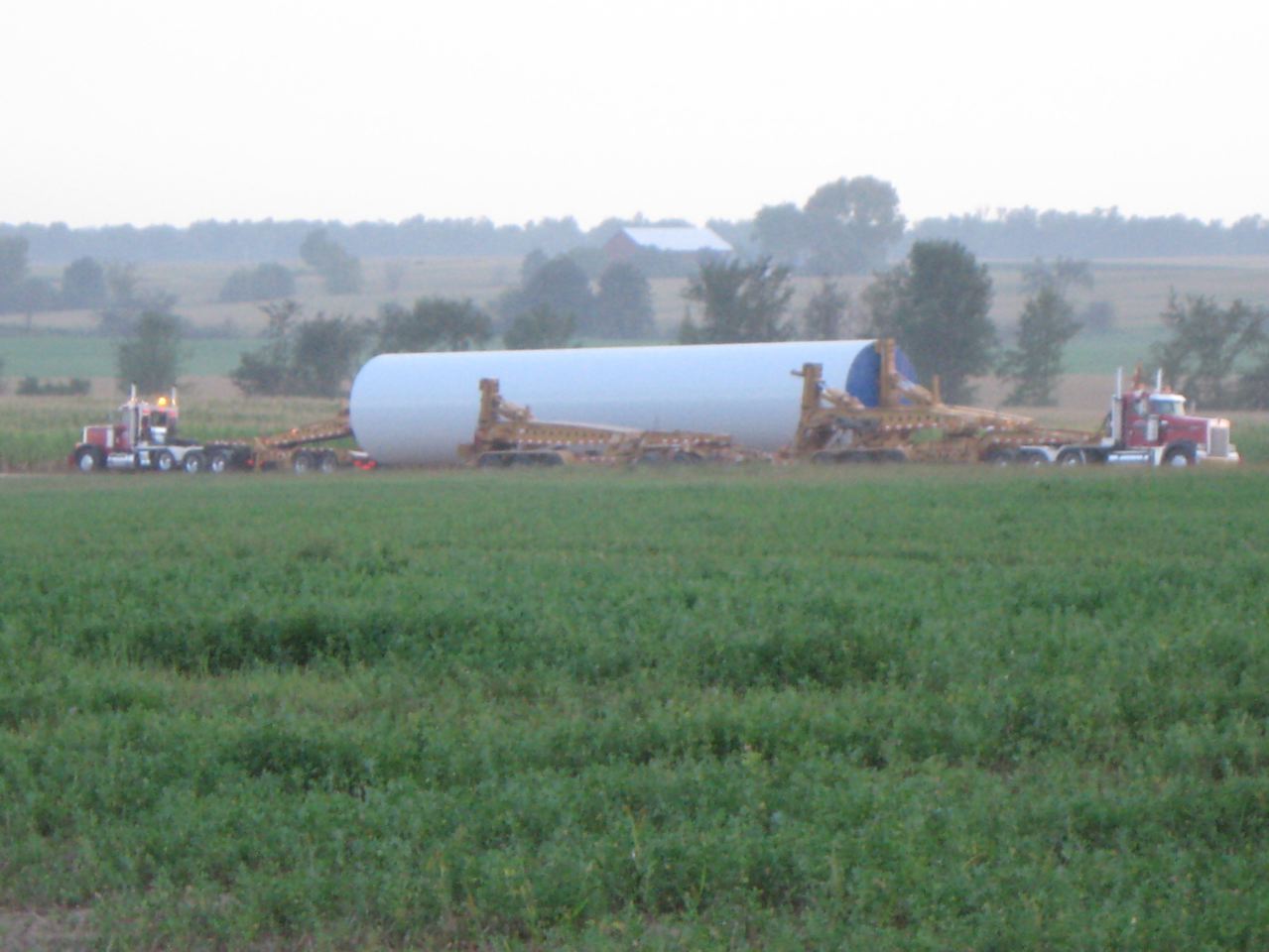
Is wind "farming" compatible with agriculture?
August 25, 2010
We're frequently reminded that wind energy and agriculture are compatible land uses. Farmers who lease sections of their crop land for wind development can continue working the soil right up to the towers and earn extra revenue for farming expenses. A win-win business opportunity, right? Not so fast. In this two-part series, Windaction.org examines the wind-farming relationship in the State of Illinois and tests the claim that the two are a good fit. As with so many topics involving wind energy, there is another story behind the story.
Back in 2007, Windaction.org posted a document entitled "What have I done?" The piece, written by Don Bangart of Chilton, Wisconsin, was based on a two- hour interview he conducted with a farmer in Northeast Fond du Lac County who agreed to lease a portion of his land for wind development. In the interview, the landowner makes several observations including this about how his land was managed:
"I watched stakes being driven in the fields and men using GPS monitors to place markers here and there. When the cats and graders started tearing 22 foot wide roads into my fields, the physical changes started to impact not only me and my family, but unfortunately, my dear friends and neighbors. Later, a 4 foot deep by 2 foot wide trench started diagonally across my field.
"A field already divided by their road was now being divided again by the cables running to a substation. It was now making one large field into 4 smaller, irregularly shaped plots. ...We soon realized that the company places roads and trenches where they will benefit the company most, not the land owner. ... All of the rocks we labored so hard to pick in our youth were replaced in a few hours by miles of roads packed hard with 10 inches of large breaker rock. Costly tiling we installed to improve drainage had now been cut into pieces by company trenching machines."
The Wisconsin farmer's experience is not unique.
Illinois has some of the best farming soil in the world with McLean County, Illinois rated #1 for the darkest, blackest most productive soil in the world.
But after extensive land moving and excavation needed to build roads and erect the turbines, farmers tell Windaction.org that the ground is never the same afterward. The fertile soil around the towers is mixed with subsurface clay and compacted resulting in lower crop yields. Depending on the lease terms, developers may compensate landowners for crop reductions but payments are often not passed on to tenant farmers who suffer the actual losses.
Since compaction is assumed to be a construction-related impact, crop-loss payments are often time-limited up to five years. However, every time turbines require maintenance, the massive crane is brought back to the site making compaction an ongoing concern throughout the life of the project. And it's not limited to existing roads or turbine pads. Turbine maintenance crews prefer to crawl across fields -- flattening crops and ground -- for quicker access to turbines needing service.
If drainage tiles are cut or damaged during construction, you're apt to see farmers working around ponds that were previously nonexistent. Or worse, adjacent fields not under lease can flood. With competition for rentable farmland so fierce, local tenant farmers risk losing their farms if they complain.
Soil compaction and drainage issues are serious concerns, but some might argue their effects are localized, and thus manageable. But that cannot be said about the impact of wind turbines on aerial spraying -- a subject that gets very little exposure.
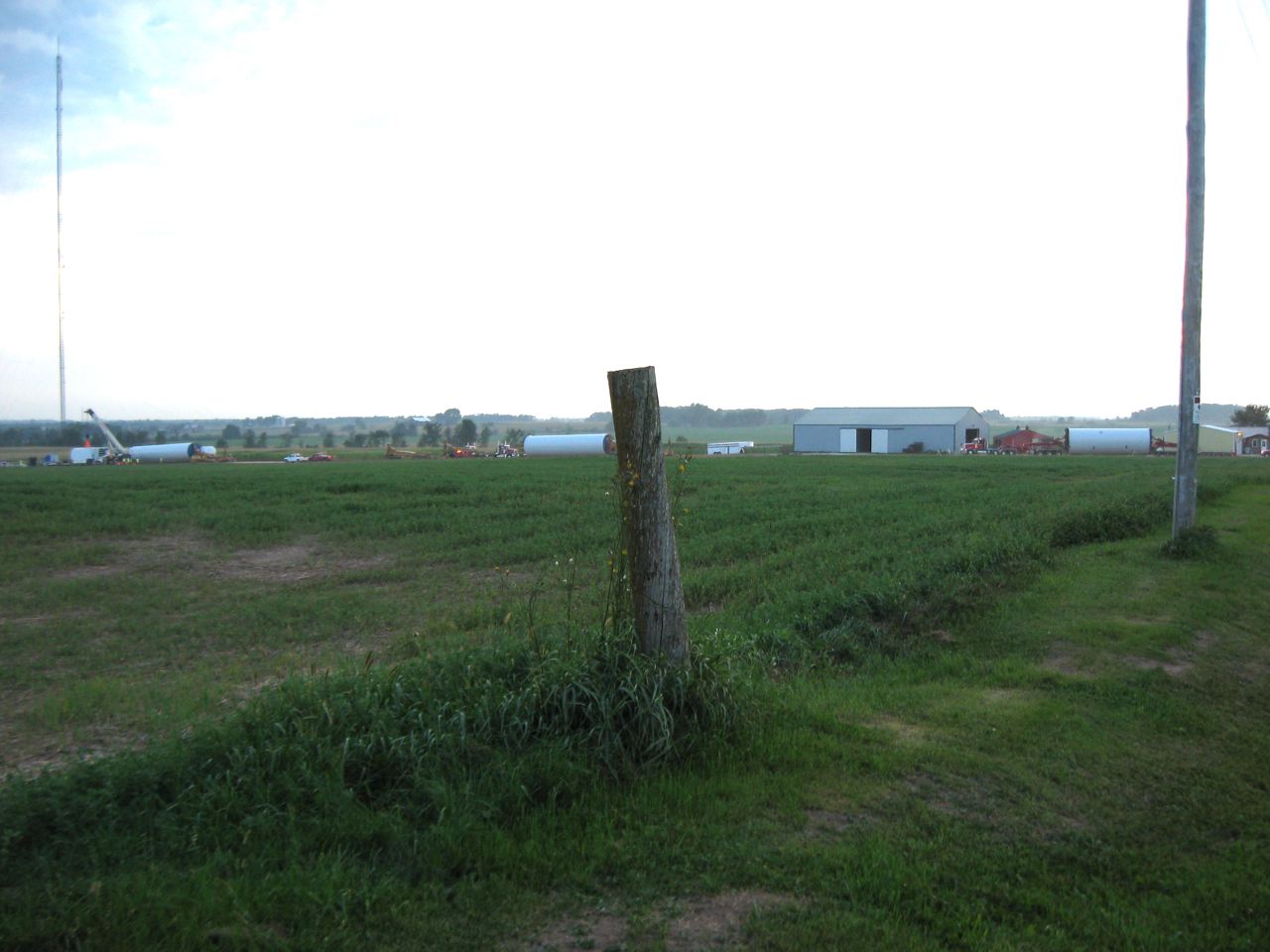
The ability to secure aerial spraying services is limited in areas where turbines are standing.
The message on the Illinois Agricultural Aviation Association (IAAA) website is clear:
"...farmers with wind generators may lose the option of aerial application of farm protection products, seed, fertilizers, etc. on their farm ground. Possibly more significant is that their neighbor farmers, who have no wind generator(s) and consequently no income from them, stand to lose that option as well.
"Some proponents of wind farms tend to dismiss this possibility out of hand, with the explanation that "those guys can fly around them with no problem," or "just get a helicopter to do it." Others say that ground application can still be effectively performed so the aerial option is insignificant. Unfortunately, it is just not that simple. Sometimes weather problems and/or timeliness of application dictate an application from the air.
"The fact is, it is dangerous to fly within the confines of a wind generator farm."
As more and more towers go up, less and less fields can be sprayed. Experienced pilots can feel the wake effect of the towers from several miles away. Such turbulence is dangerous to fly through.
Helicopters may be recommended because they travel at slower speeds and can work in more confined spaces but they can't carry the same loads meaning more trips at higher costs. There are far fewer helicopters in the State (under 10 in total) so timely availability is a critical issue.
Some farmers try ground applicators but aircraft can cover crops faster and more efficiently than any ground rig. In cases of Asian soybean rust, farmers could experience an 80-100% yield loss if not treated within a week. Aphids or spiders mites can destroy a field within days. If infestations occur during wet years ground equipment on wet soil will cause compaction or ruts that lead to erosion.
Illinois County Boards tasked with approving new wind development appear willing to accept that aerial applications are still possible but with more difficulty and at a higher cost (most spray policies charge premiums up to 50% above standard costs on fields within a mile of the towers, whether a participating landowner or not). What they do not seem to realize is that as more wind farms are permitted, the cumulative effect will lead to fewer and fewer fields that can be sprayed, making total crop loss a real possibility.
Since crop insurance will not cover the farmer in cases of insects or plant disease where damage is "due to insufficient or improper application of pest control measures or disease control measures", crop loss could lead to significant financial losses for farmers.
Illinois farm land has nearly 1900 megawatts of wind turbines installed across thousands of acres of farm land and thousands more slated for development. Absentee landowners may be gaining financially from the development, but the idea that "wind farming" is a compatible agriculture use is more myth than reality in Illinois.
Special thanks to Rick Reed, president of IAAA, who provided valuable information on aerial spraying.
Wind Turbines in the News
For the latest national and international wind news visit
News
GREEN PARTY OF CANADA CALLS FOR WIND TURBINE HEALTH STUDY:
Source: Green Party of Canada Website
Considerations:This motion, in calling for a study on the human health effects of wind turbines, would create a new policy and could potentially call into question some of the party's policies on significantly increasing the amount of energy produced through wind turbines.
Motion Preamble:WHEREAS the Green Party of Canada recognizes the vast potential for wind energy in Canada;
WHEREAS the Green Party of Canada with the Canadian Wind Energy Association has set goals for Canadian wind energy generation;
WHEREAS many citizens in communities with wind turbines claim to be experiencing sleep deprivation, headaches, and heart complications related to wind turbines;
WHEREAS one of the largest obstacles preventing accelerated wind energy development is resistance from citizens near planned turbine sites;
WHEREAS the largest investment Canadians make, their home, is affected as much by real health risks as perceived ones;
WHEREAS many provincial governments have compromised their objectivity with respect to wind energy development;
WHEREAS the Green Party of Canada considers healthy people and healthy communities as necessary for a strong Canada;
Motion Operative:THEREFORE BE IT RESOLVED that the Green Party of Canada seeks to have Health Canada initiate an epidemiological study on the human health effects of wind turbines in the interests of public health and safety.
Dong giving up on land-based turbines
Mass protests mean the
energy firm will look offshore
SOURCE: The Copenhagen Post Online
September 1, 2010
State-owned energy firm Dong Energy has given up building more wind farms on Danish land, following protests from residents complaining about the noise the turbines make.
It had been Dong and the government’s plan that 500 large turbines be built on land over the coming 10 years, as part of a large-scale national energy plan. This plan has hit a serious stumbling block, though, due to many protests, and the firm has now given up building any more wind farms on land.
SOURCE, ” On the Level: Quarterly Newsletter of the Vestibular Disorders Association (Summer 2010, p. 9)“Wind Turbines Can Affect Inner Ear Function,
Scientists have determined how infrasound from wind turbines may influence inner ear function.
An increasing number of people living near wind turbines report a group of symptoms termed “wind turbine syndrome” that include sleeplessness, dizziness, fatigue, ear pain and pressure, difficulty concentrating, and headache.
Up until now, many scientists who study hearing claimed that noise from wind turbines couldn’t be harmful because it occurred at a frequency too low for most people to hear.
Researchers at Washington University in St. Louis, Missouri successfully challenged this conventional wisdom that “what you can’t hear won’t hurt you.” They noted that one type of inner-ear sensory cell behaves differently when encountering infrasound.
Usually these cells respond to sound by contracting and expanding proteins within their walls, amplifying vibrations, which in turn stimulate other sensory cells to send electrical signals about sound to the brain. However, the proteins do not respond in the same way to infrasound and instead actively prevent stimulation of the cells that transmit sound signals.
So, while the brain may not receive information about sound, a physiological response to infrasound has occurred in both the cochlea and the other sensory structures in the inner ear such as the saccule, possibly explaining the unfamiliar sensations experienced by some people.
Reference:
Salt AN, Huller TE. “Responses of the ear to low frequency sounds, infrasound and wind turbines.” CLICK HERE TO DOWNLOAD Hearing Research 2010 Sep 1;268(1-2):12-21. Epub 2010 Jun 16.
8/22/10 What to expect when you're expecting wind farm construction AND what do wind tubines sound like?
WHAT'S THE PROBLEM?
Click on the image below to hear the noise from a wind turbine 1100 feet from a home in the Invenergy Forward wind project in Fond du Lac County, Wisconsin. Because of the noise, this home is now for sale.
8/19/10 Wind farms and wildlife, What to expect when you're expecting wind farm construction, and what's the big deal about shadow flicker? AND Wisconsin in two years time: A look at what wind siting reform has done to the state of Maine
Wind farms and wildlife: The heartbreak of the Horicon
Wind farms and Bats:
How are bats being killed in wind farms?
WIND FARM CONSTRUCTION VIDEOS
Video of what kind of changes a wind turbine brings to a farmer's fields.
Trenching and electrical cables
Access roads and soil disturbance
Torn up roads and compacted soil
Heavy equipment and cranes compact soil
How big are the shadows cast by industrial scale turbines? What do they look like? Why are they a problem?
What is shadow flicker like on houses in Wisconsin wind projects?
SECOND FEATURE
RESIDENTS SAY STATE RULES FOR WIND FARMS LACKING
SOURCE: Sun Journal, www.sunjournal.com
August 19 2010
By Eileen M. Adams
DIXFIELD — Panelists and townspeople at a public hearing Wednesday night blasted what they believe are insufficient state regulations to govern the half-dozen or so wind farms proposed for western Maine.
The hearing was sponsored by the River Valley Alliance and the Friends of Maine’s Mountains, groups that oppose such developments. Other groups, such as the Friends of Spruce Mountain in Woodstock, were also at the hearing.
Among the panelists was Robert Rand, an acoustical engineer from Brunswick, who described the potential effects on people of the sounds made by the blades and generators of turbines.
During much of his talk, he played a recording of a turbine operation he said was made at a small operation in Freedom.
Such noise, he said, has the potential to adversely affect people living as close as 2 miles from an operating turbine. He said the frequency and decibel levels could result in the inability to sleep, high blood pressure and other maladies.
Paul Druan, chairman of the Weld Windpower Committee that is charged with developing a wind farm ordinance, said that when he attended a similar forum with the sound of turbines turning, one man became nauseated.
Sean DuBois, whose residence was not immediately available, said he believed more studies should be conducted on the possible adverse health effects.
“Don’t you think it’s too early to judge health effects?” he said.
Rand said he didn’t think so.
“There are people in Mars Hill, Freedom and an island on the coast who definitely have problems,” he said. “I’m concerned about the lack of peer-reviewed studies by the companies.”
He said that sounds from turning turbines do not decrease as quickly over water as they do over land.
A home should not be located less than 2 miles from a turbine, and even then, the sounds could affect people, he said.
Also speaking was Karen Pease, a resident of Lexington Township which is next to the state’s largest proposed wind turbine project in Highland Plantation. Independence Wind LLC, whose principals are former Gov. Angus King and Rob Gardiner, have proposed construction of 48 turbines.
She spoke of the effect the siting of wind turbines could have on real estate. She said Maine doesn’t have a sufficient number of houses on the market to do comparable studies, but one done in Illinois showed at least a 25 to 40 percent drop in value for homes about 2 miles from a wind project.
“Some are a total loss,” she said.
Also, she said, wind developers are not being required to provide a bond for decommissioning turbines so that they could be taken down and the land reclaimed.
Dan McKay, a major player in the organization of the hearing, said that with the number of people who live in the River Valley area, building what he estimated to be about 100 turbines made little sense.
“Turbines are a chance to shut down the recreational opportunities in the area,” he said.
Nearly 200 proposed turbines are in various stages of development from the Rumford area to Highland Plantation. First Wind LLC of Newton, Mass., has proposed siting up to 19 turbines in Rumford and Roxbury; Independent Wind LLC is proposing the Highland Plantation project and 22 turbines in Roxbury; and Patriot Renewables LLC of Quincy, Mass., has proposed a total of about 50 turbines in Carthage, Dixfield, Canton and Woodstock.
McKay said signatures were being gathered on a petition asking the Maine Department of Environmental Protection to change the acceptable decibel level produced by turbines to 5 decibels above the ambient level in an area currently without turbines.
He said the signatures collected in several River Valley towns and Woodstock would be sent to the Citizens Task Force, which is circulating a petition statewide calling for more regulations on wind development.
8/14/10 TRIPLE FEATURE: The problem with the "successful" community wind project touted by Wisconsin wind siting council member AND Another chapter of "Wind Developers Behaving Badly": What part of "Conflict of Interest" don't you understand? AND Wisconsin looks in the mirror and keeps seeing Maine
NOTE FROM THE BPWI RESEARCH NERD: At a recent Wind Siting Council meeting Vinalhaven was touted as an example of a "community" wind project that was working.
Residents now trying to live with "community" turbine noise have a different view.
Noise controversy over Vinalhaven wind turbines heats up
SOURCE: The Free Press, freepressonline.com
August 12, 2010
Vinalhaven sits 15 miles off the coast and just over an hour’s ferry ride from Rockland, but it has an old-fashioned sense of community rare on the mainland these days. Every driver waves as they pass and it’s common for an islander to leave the keys in the truck in case anyone needs to borrow it.
It was with that sense of community that the islanders welcomed the three wind turbines to Vinalhaven last year. Not only did the turbines promise reliable electrical service, which was something long-term residents did not take for granted, but wind power would lower electric rates for everyone.
Islanders turned out in strength last November to see the turbines started up, watch the 123-foot-long blades sweep the air and watch grade-school children do a windmill dance to the tune of “I’m a Little Tea-Pot.”
Even with some initial start-up glitches, rates have gone down when averaged across the year (the estimated average rate is now five to six cents per kilowatt hour, with variations from month to month, according to Fox Island Electric Cooperative; the national average rate was 11.36 cents per kilowatt hour in 2008).
Most of the 1,200 or so residents on Vinalhaven approve of the turbines. But within days of start-up a handful of Vinalhaven residents who lived within a mile of the wind turbines on the North Haven Road reported noise problems.
Nine months later, people have taken sides. Fingers are being pointed. Frustration levels are rising. There are rumblings about complainers and how they should move off the island if they don’t like it. There are accusations of misinformation and biased noise data collection.
Jeanne Bineau-Ames, whose house is near the swimming quarry in the middle of the island, summed it up.
“It’s an island. We are only as strong as the smallest link. We have to work as a community,” she said. Bineau-Ames lives far enough from the wind turbines not to hear them, has a relative on the board of the electric cooperative who strongly favors them, and sympathizes with those affected by the noise.
“I hate to see this go to mistrust and anxiety,” she said. “We have to work at this. We have to work this out.”
Sound Effects
Bothersome noise related to wind turbines is hardly new.
“Wind turbine noise is becoming a bigger issue in the U.S.,” said Patrick Moriarty, an aeronautical engineer for the National Renewable Energy Laboratory (NREL) in Golden, Colorado. NREL belongs to the U.S. Department of Energy and is the primary research and development site for energy efficiency and renewable energy, including wind power. Moriarty is a senior engineer at the lab.
“It’s been a big issue in Europe for a while because their wind farms have been up longer and they are in more densely populated areas,” Moriarty said.
In Maine, the Mars Hill wind farm in Aroostook County and the turbines in Freedom in Waldo County have elicited similar complaints by nearby residents who say the repetitive whump, whump, whump sound of the blades turning causes sleeplessness and anxiety. Some research suggests those symptoms could be related to low-frequency sound waves that impact people as a pressure wave.
Sound seems simple enough: you hear it or you don’t; it’s audible or it isn’t. It turns out that sound is far from simple: not only can a noise that is alarmingly loud to one person be a minor note to another, but some people appear to be affected by low-frequency sound-the bass notes-while others aren’t. And the really low frequency sounds (below 20 hertz), the inaudible sound waves, which elephants and whales use to communicate over long distances, can travel hundreds of miles without fading. It’s this silent sound that may make birds and beasts aware of earthquakes and tsunamis ahead of any apparent danger, and it may be the cause of a laundry list of human complaints that include sleeplessness, anxiety, exhaustion and depression.
Or it may not be. The jury is out.
Dora Anne Mills, the medical doctor for the state of Maine, reviewed the medical and acoustics research on wind turbine noise and issued a 2009 report stating that the current research on health effects was inconclusive. Mills concluded there was insufficient evidence to change state noise compliance standards.
But the thing to understand, said Moriarty, is that the sound coming from the wind turbines is broadband noise; that is, it has all frequencies mixed together. It appears not to be the volume of the turbines, but the rythmic nature of the noise, the whomp, whomp or whoosh, whoosh, whoosh-what Moriarity refers to as the modulation-that is problematic, but no one is really sure.
“Noise ordinances are now based on amplitude [volume],” said Moriarty. “Some people think modulation noise [repetitive, rhythmic noise] could be more annoying.”
“It’s an open question if noise regulations should be adjusted for modulation. It’s at the bleeding edge of research at the moment and it’s where technology and sociology overlap,” said Moriarty.
That’s cold comfort to some residents who live close to the wind turbines.
Britta Lindgren lives about a half mile down the Northhaven Road from the turbines.
“Initially, the animals went off their feed when the turbines started up. During the first few days after they started, I found an eider duck hiding in the corner of the porch, cowering. You never see eider ducks out of the cove. I’ve never seen that. During the first two or three weeks, it was really loud.”
“The animals don’t do that now. Truthfully, most of the time it’s not a problem,” said Lindgren, referring to the volume. “There are trees between us and the sound varies in intensity. It’s a whomp, whomp, whomp sound.”
They may not be so loud, but the sound pulses rythmically. Lindgren believes the repetitive noise is what is creating sleep problems in her family and, she says, it isn’t something that you just get used to, as some islanders have suggested.
“It feels like a constant wearing down,” she said. “It’s like when you have an itch. It’s nothing to scratch it, but then it keeps itching and you keep scratching and before you know it you have a hard, raw spot. It hurts. You’re always aware of it.”
A half mile in the other direction, Erin Creelman and her family are more acutely aware of the wind turbines. Their house sits on high ground across from them and all but one of the family members are having problems sleeping.
“We left our storm windows in this summer, and we have thermal panes,” said Creelman. “We didn’t put in the screens. We have a well-insulated house with wood panels and sheetrock. We have blown-in fiberglass. You can still hear them. You can feel them, really. It’s a pressure thing more than a noise. It’s like a whomp, whomp, whomp.”
Creelman said she supported construction of the windmills and doesn’t want them taken down; she wants the sound issues solved.
Lindgren agreed, but shook her head at the possibility of a solution.
“It’s gotten quite divisive,” said Lindgren. “How do you deal with that? I don’t know.”
Sally Wylie, another neighbor of the wind farm who lives less than a mile away from the turbines, didn’t parse her words. She was thoroughly frustrated.
“They said it would sound like the humming of a refrigerator. That didn’t seem so bad,” said Wylie.
But Wylie said it isn’t like a refrigerator.
“It sounds like a jetport,” said Wylie, referring to the noise in the windy winter months. “It’s unbelievable. It vibrates right through the house. It ricochets off the neighbors and comes back. It echoes.”
The Neighbors & The Man Behind the Machines
“There are about 15 to 20 year-round houses located within three quarters of a mile of the turbines,” said George Baker, who is the CEO of Fox Island Wind, a private enterprise that is a subsidiary of the Fox Island Electric Cooperative (FIEC) and that was formed to allow the wind turbines to be built.
Notably, the wind turbines have overwhelming support from Vinalhaven residents; only a handful of people are affected by the noise.
“I live with 4 a.m. lobster boats,” said Donna Payne, who owns the Payne Homestead bed-and-breakfast in town. “These are the sounds of people going to work. That’s what it takes to live on an island.”
The wind turbines can’t be heard in town.
“What noise?” said Pete Gasperini, when asked what he thought about the wind turbine noise. “We love them.”
Carla Harris, who sat next to Gasperini at a public forum, agreed.
“We’ve gone up close to hear them and we’ve gone further away,” said Harris. “This is not unbearable noise. It’s like ambient sound.”
Annette Philbrook also agreed.
“The old power plant made ten times more noise than these,” said Philbrook.
Nans Case, a 20-year resident of Vinalhaven who lives in town, said she’s a fan of the lower electric rates.
“My rates have gone down 25 to 30 percent,” said Case. “That’s something for someone on a fixed income.”
But those who are bothered are really bothered. Some of those who live close to the turbines sought legal advice, citing bad faith on the part of Fox Island Wind in adhering to a tolerable noise level and in not addressing their concerns as a serious community issue.
Wylie is one of the neighbors who became vocal about the need to address the noise problem.
“We were big supporters of the project, but we were told the ambient noise would mask the sound of the turbines, so when the turbines were turned on, I was completely in shock,” said Wylie. “I called George Baker and said, please, can you turn them down?”
“He said ‘I can’t do that. We have to study the sound
issue,’ ” said Wylie, who thought the impacts of the nearby neighbors were part of the equation for how the turbines should operate.
“We believed what they told us,” said Wylie.
Now she thinks Fox Island Wind considers the neighbors a nuisance.
“We were totally naive,” she said.
Wylie and others bothered by the turbine noise formed Fox Island Wind Neighbors (FIWN) and launched a website to share information.
“During the first two and a half months after the start-up, I spent hours every week talking to the neighbors,” said Baker, who in addition to being the face of Fox Island Wind is a professor at Harvard Business School who has been on an extended leave of absence so he could serve as the vice president of Community Wind at the Island Institute in Rockland.
“I gave them a whole bunch of detailed financial information and technical information,” said Baker. “Probably stuff I shouldn’t have given. I told them I wasn’t talking to my lawyers, because I knew if I did, my lawyers would say: ‘Don’t talk to them.’ I didn’t want it to be like that.”
“I did tell them if they retained a lawyer, I’d have to talk to my lawyers and I knew what they would say,” said Baker. Fox Island Wind’s lawyers said what Baker expected: stop talking to the neighbors who retained legal counsel.
“There is no lawsuit. I desperately hope there isn’t one. but we got into that lawyer thing and I hate it,” said Baker. “So, no, I won’t talk to them.”
Wylie sees it differently. She says there is no intention to sue, nor was there, ever.
“We needed legal advice. Our lawyer advised us to keep working with the DEP and the community,” she said. “To keep talking.”
“There’s an ethical question here,” said Wylie. “Do you sacrifice the small part of the population or just focus on what the majority wants? Why didn’t they just say, ‘Guess what? This isn’t really working. This is a lot louder than we thought and it’s not a good thing.’?”
“We need to make it work,” she said. “We’re a community. We have a problem, but we’re part of the community package. It’s not like you can throw us out with the laundry.”
Baker, whose unbounded enthusiasm for the Fox Island Wind project comes across without restraint, reined in when it came to talking about the noise controversy.
“I can’t tell you how frustrated I am. I have an enormous stake in this. I’m not making a dime on this project, I hope that is clear,” said Baker, who does not get a salary for being CEO of Fox Island Wind. Baker’s Harvard Business School scholarship recently focused on negotiating and contracts that are built on trust and secured by the reputation of those involved, not on legal enforcement.
“I care deeply about getting this issue resolved, with community involvement,” Baker said. “My reputation is at stake.”
Compliance with State Sound Standards
The state of Maine has noise compliance standards that are pretty straightforward for windmills. When it comes to frequencies and decibels, they take their measurements from the middle range, with attempts to correct for the low-frequency part of the range.
Under Maine state law (Title 38, Sec. 343), wind turbines sited in a quiet location like Vinalhaven cannot operate any higher than 45 decibels at the property line of abutting landowners. Communities like Vinalhaven can adopt more restrictive local ordinances. Vinalhaven had a more restrictive noise ordinance, but voted it out in favor of the state standards.
“Sound is measured between May 1 and August 31, during the inversion period,” said Becky Blais of the Maine Department of Environmental Protection. Blais monitors compliance for the Fox Island Wind site. Inversion is the term for when there is wind aloft and it is calm near the ground. The premise is that sound will carry farther during the summer inversion period; though, on the island, wind blows much harder in the winter.
“All we are measuring is state compliance,” said Blais. The DEP asks Fox Island Wind to collect data using a DEP- approved method. That raw data and initial analysis is sent to DEP for further checking of accuracy and analysis. Complaints from neighbors, with specific time frames attached to the complaints so they can be correlated to sound collection data, also go into the mix for analysis.
The state, in essence, is measuring volume using a standard approach used by federal agencies for measuring industrial noise. They are not measuring low frequencies, which tend to travel farther and in lots of directions. Higher frequencies, in contrast, tend to travel in one direction for much shorter distances.
Fox Island Wind Neighbors takes issue with the state compliance standards of 45 decibels at the property line of an abutting property. They think it should be lower. Even so, FIWN wanted to determine for themselves if the turbines complied with existing state sound standards, so they took the intiative to collect their own sound data from an abutting property, starting this past April. It’s a nonscientific study, but it does indicate that the turbines routinely exceed 45 decibels. FIWN shared their information with the Maine DEP in an effort to bolster their position that the turbines are louder than they should be.
Several sound studies have been done on Vinalhaven or are in the process of being conducted.
Study #1: Turning the Turbines Down
The Noise Reduction Operations (NRO) studies, which were undertaken at the request of Fox Island Wind last spring, included randomly turning down the turbines to see if there was any effect on nearby residents. Only nine participants submitted logbooks noting when they heard turbine noise and how they felt; but 200 responses came from those people.
Ben Hoen of the Berkeley Naitonal Laboratory at the Department of Energy was the principal researcher.
Hoen said the small sample size was, to some extent, offset by the number of responses received.
“There is no silver bullet when it comes to a solution here. It’s all shades of grey,” said Hoen. What the study did do was indicate that the complaints of sound effects, which were recorded with a date and a time, were correlated with wind speeds at the wind turbine site and at a buoy 10-15 miles away.
“The study method worked,” said Hoen. “We hope to come back a second time. Ideally, you want every single person to participate.”
Study #2: Cancelling Out the Noise
Conquest Innovations, an acoustics consulting firm based in Washington state, approached Baker of Fox Island Wind to see if they could set up an experimental study to attempt to fine-tune existing technology so it would work to cancel out the sound of the wind turbines.
Baker secured a $12,000 matching grant from the Maine Technology Institute to kick off the experiment to explore the use of noise-cancellation technology on wind turbine sound.
“We’ve been looking at the full sound spectrum, with the focus below 250 hertz,” said Steven Bradbury of Conquest Innovations. Active Noise Cancellation is based on recognized principles. Bose has used it in its noise-cancellation headphones and Honda has used it inside the cabin of some of its models to cancel out engine noise.
Bradbury explained how noise cancellation works.
“You ever been out on a boat? You know when two boat wakes come from two different directions… say, each wave is six inches high. When the crest of the two waves meet, they double and the peak is about 12 inches high. Now take the same two waves, but instead of the crest of one wave hitting the crest of an oncoming wave, it hits the trough.”
Anyone who has crossed to Vinalhaven has seen it. When the crest of one wave hits the trough of an oncoming wave, the water briefly flattens out. The waves essentially cancel each other out, creating a momentary calm.
Sound waves are not exactly like water waves.
“But this is a great way to visualize what we are trying to do,” said Bradbury.
Lower-frequency sound waves have crests that are farther apart than high-frequency waves; simply, they are less frequent. Think of the sound of the bass on the subwoofers coming out of a car passing on the road in the summer, with the music turned up high. The low-frequency sound comes right through the walls. It goes in all directions; the thumpa, thumpa, thumpa of the bass, until someone says out loud, “Jeez, can’t that kid turn that down?”
The crests of the low-frequency waves are farther apart, thus giving Active Noise Cancellation (ANC) technology room to emit a sound that will flatten the wave. To cancel out three windmills will take three carefully calibrated speakers that are programmed to respond. The result: no more thumpa, thumpa, thumpa. ANC doesn’t mask the sound wave; it meets it and gives the thumpa right back to it.
“We’re pretty excited about this,” said Bradbury. “The principles of active noise cancellation are proven. We know it works.”
According to Bradbury, the direction and speed of the wind shouldn’t make much difference in the effectiveness of noise cancellation.
“What isn’t clear is whether the sound that is bothering people is just low frequency,” said Bradbury. Noise cancellation won’t work on high-frequency sound as effectively: the sound waves are too close together to flatten out across large areas. They are also directional and don’t go through house walls as effectively as low-frequency sound.
So, what happens if the bothersome noise is partially low-frequency and partially high-frequency sound waves? Or even a resonance effect created by extremely low frequency sounds essentially shaking the walls of a house and creating new sounds.
“It may not work,” said Bradbury. It won’t take much longer to find out. The sound data has been analyzed, a sound profile is being created, and Bradbury said a bench-top demo model will be ready in under two months.
Study #3: The Colorado Department of Energy Lab
On March 1 of this year, Baker requested that the National Research Energy Lab come out to Vinalhaven because he thought the lab could help FIW better understand the sound issues. NREL agreed and committed an initial $30,000 to pay for the studies.
Moriarty of the NREL/DOE lab in Colorado and Ben Hoen of the Berkeley DOE lab in California have been looking into the effects of the wind turbines and trying to tie them to specific sound signatures. The data from the Noise Reduction Operation are their starting points, but they got a more complete assessment of impacts than the survey done by Fox Island Wind, said Moriarty.
“The idea was to be independent from Fox Island Wind and to maintain objectivity, ” he said. “Of course, we wouldn’t identify the people who spoke to us.”
Moriarty stressed, again, that the turbines create broad- band noise across low to high frequencies.
“The noise is definitely related to speed. The dominant noise comes from the blades. The faster they spin, the louder they are, but the faster they spin, the more electricity they produce,” said Moriarty, noting there will be a trade-off between reduced noise and electricity generation.
What NREL is looking for is specific symptoms or noise irritation (sleeplessness, irritation from loudness, etc.) at specific times, so they can tie them to the sound data. The NREL team plans to correlate that social data with a variety of other factors, including wind speed, turbine volume, humidity, inversions, and modulation.
What they found in their initial data collection on Vinalhaven was that noise annoyance didn’t necessarily correlate with proximity to the turbines.
“There may be lots of sociological factors, from not wanting to be perceived as a bad guy in the community, to some people working away from home during the day while others are at home gardening. I think that was a big factor,” said Moriarty.
Some other research questions have come up. How does proximity to the ocean, where the atmosphere almost traps the noise, come into play? Another is the base rock the turbines are built on top of.
“One question that came up at Vinalhaven is that the turbines are connected to granite. That’s not very common anywhere in the world. It’s a solid connection and it may be a more efficient transmitter of noise. Here in Colorado, we have the exact same turbine that is on Vinalhaven. You can hardly hear it. But the soil is very different here.”
The next step will be to break down the sound signature and try to isolate the cause of the noise that annoys people at specific times.
“Is it the blades, the rotor? Is the reduced noise operation working the way it should? That’s what we’ll be looking at,” said Moriarty. “Then we’ll brainstorm mitigation potential, and costs and effectiveness. We may recommend reducing speed; even more expensive is a new blade design. They may be able to reduce the operation so much and pay so much more for electric. Then we present it back to the community: Here’s what we found. It’s your island. What would you like to do?”
But what about the sounds that are so low they can’t be heard? Called infrasound, the super low frequency sounds that register below 20 hertz.
Moriarty launched into a cautionary tale. A large experimental windmill was built in Boone, North Carolina, in the 1970s, with the wind at its back in order to maximize energy generation. But the low-frequency noise created pressure waves that were amplified by a number of factors.
“It created a pressure pulse low enough that you couldn’t hear it, but it was similar to the resonance frequency of houses and the sound wave shook the houses and increased the amplitude. Body cavities have a similar resonance frequency, too, so people were getting seasick and dishes were falling off the walls.”
“That’s the number-one reason wind turbines are now designed to work upwind. Infrasound is much less of an issue. Recent measurements on infrasound of GE turbines on Vinalhaven found there isn’t much infrasound coming from those turbines and they satisfy national standards,” he said.
Moriarty said that everything he has seen on infrasound seems to indicate that the noise-related problems are not due to infrasound.
But noise problems are real and the industry is paying attention.
“Sound is a focus across the wind industry,” said Melissa Rocker, the global communications manager for General Electric, who manufactured the wind turbines on Vinalhaven.
“We’ve been talking to Fox Island Wind since last November on how to reduce noise,” said Rocker.
“Every site is unique, with different geographic conditions, weather conditions and ambient sound levels,” she said. “GE is working on various technologies….When those technologies are ready, Fox Island would be a strong candidate for testing.”
The Sculptor at the End of the Lane: Kitty Wales
Fred Granger, who works at a small quarry cutting granite for countertops and benches using a diamond-bit granite saw, hasn’t been drawn into the conflict or paid much attention to the studies.
“I love them,” he said of the wind turbines. He works in the shadow of the windmill blades and the sound of his granite saw is loud enough to drown out any turbine noise.
“They’re beautiful machines that take air and make electricity,” he said. “But I don’t live on the island.”
And then he walked past the numbered blocks of fine-grained granite to the edge of the North Haven Road and pointed down a long lane bordered by hay-scented fern and bayberry bushes.
“There’s a sculptor lives down there,” he said. “Close enough, but a little further away than the rest. She might be one to talk to. I don’t know what she thinks of them. I don’t know that she’s been asked.”
I started walking down the sunny lane, breathing in the summer island scent of sweet fern, hay-scented fern and wild roses. Jim Cogswell was clearing brush on the side of the lane a quarter mile in and stopped for a chat. Cogswell lives on the Peaquot Road on the other side of the island.
“What do I think of them? Anything to get us to use less oil from the Arabs, I’m for them,” said Cogswell. “It’s funny, though. You can hear them from farther away than you can when you are right up close to them.”
The sculptor at the end of the mile-long lane turned out to be Kitty Wales, who is on the island for five months. It’s where she gets her sculpting work done; the rest of the year she teaches in Boston.
No one had asked her what she thought.
“The sound varies wildly,” said Wales. “Some days I can’t hear it at all. Other days it’s this engine sound, whomp, whomp, and a rattling sound on a really bad day. Sometimes there is this low vibration. But I’m three quarters to a mile away and it’s only when we are in the lee of the wind that I hear it.”
“It’s basically too close to residential, too close to homes…and it’s done. For me, it’s tolerable. I don’t want it to affect my work, so I put it out of my mind as much as I can. I don’t think they will be able to make it quieter, but they seem to be trying.”
“Have you gone up the lane, with the pristine look of the bayberries and the hay-scented fern and there they are?” asked Wales. “Rising up in front of you? They are so beautiful. As a sculptor, I think they’re amazingly cool.”
Second Feature:
State probing officials at Cape: Misconduct alleged in wind development
SOURCE Watertown Daily Times, www.watertowndailytimes.com
August 14, 2010
By Brian Kelly, Times Staff Writer,
CAPE VINCENT — The state attorney general’s office is investigating allegations of misconduct by “certain” town officials in connection with the development of wind farms.
John T. Milgrim, spokesman for the attorney general, confirmed that a letter was sent to the town and its attorney Friday afternoon informing them an investigation had been launched.
Mr. Milgrim also confirmed that two senior members of Attorney General Andrew M. Cuomo’s staff, Deputy Chief of Staff John B. Howard and Henry M. Greenberg, executive division counsel, were in Cape Vincent about two weeks ago conducting interviews of “parties interested in wind power.”
Mr. Milgrim declined comment on details of the investigation, including what prompted it or which town officials may be its focus.
According to the letter, obtained by the Times, the attorney general has told the town it must preserve all town documents, including those of the Town Council and Planning Board, and the town is not to delete or purge any records until the investigation is complete.
The attorney general’s office is specifically requesting information about any present, past or future wind farm development or siting of the farms, as well as all information regarding wind turbines, wind power and related facilities or wind power projects.
The office wants all information about wind farm development compiled since Jan. 1, 2005, “whether considered, planned, attempted or completed, including, but not limited to permitting, licensing, construction and energy production.”
By Aug. 28, the attorney general’s office wants:
■ All documents relating to town action on wind farm development, including, but not limited to, board minutes, board packages, resolutions, voting records, communications, permits, applications and licenses.
■ All communications between or among town officials and any company engaged in wind farm development.
■ All documents concerning any financial relationship between a town official, or their relatives, and a company engaged in wind farm development, including, but not limited to, any financial disclosures filed with the town and any board minutes reflecting any such disclosures.
The attorney general’s office is asking that town Supervisor Urban C. Hirschey and Planning Board Chairman Richard J. Edsall, as well as members of the Town Council and Planning Board, be made available for interviews. The office also wants to talk to anyone else who served on either board since Jan. 1, 2005.
Acciona Wind Energy USA has proposed a 51-turbine St. Lawrence Wind Farm for the town and BP Alternative Energy has an active application for the 62-turbine Cape Vincent Wind Farm. The proposed projects have caused controversies between pro- and anti-wind advocates, including allegations of conflicts of interest among town officials.
Third Feature:
Open Access to Paperless Records
SOURCE: The Times Record, www.timesrecord.com
August 13, 2010
Maine’s Freedom of Access Act is based on the principle that government best serves the public when it operates in the most open manner possible. Without open meetings and access to public records citizens won’t know what their government is up to — and democracy can’t function properly.
So it should be a matter of grave concern to all Maine citizens — not just the press — that the Maine Center for Public Interest Reporting essentially had a roadblock thrown in its path this spring when it requested documents from the Maine Public Utilities Commission as part of its research into the 2008 law to fast-track wind turbine development in the state.
As reported by the center’s Naomi Schalit in the three-part series that ran this week in The Times Record and several other Maine newspapers, the Wind Energy Act of 2008 implements a set of recommendations made unanimously by a task force named by Gov. John Baldacci in 2007.
The resulting legislation wasn’t even debated when it was approved unanimously by the Maine House and Senate. As Schalit notes in her first article, it “was a special interest bill justified at the time in the name of jobs, energy independence and climate change.”
Not surprisingly, given the lack of debate and scrutiny as the bill flew through the Legislature in 2008, it took time for the public to grasp what the Wind Energy Act’s ambitious goals of constructing 1,000 to 2,000 turbines by 2020 actually means … and the impact that might have on Maine’s western mountains.
What Schalit has done is raise important questions about the process by which this major piece of legislation became law. Key among them is how the governor’s task force created a map showing where wind turbines could go to receive fast-track consideration. What she discovered is that it’s not clear from the official record, largely because summaries for the task force’s last two meetings don’t exist.
The lack of a paper trail is an obvious red flag, and dogged reporter that she is, Schalit used the obvious tool for any Maine citizen curious about how laws and policies come about: She filed an FOAA request with the Maine Public Utilities Commission, whose former chairman, Kurt Adams, had accepted a job with the wind power company First Wind in April 2008.
Schalit sought e-mails from 2005 to 2007 between Adams and First Wind, between Adams and Baldacci (for whom he had previously worked as legal counsel), and between Adams and several wind power attorneys employed by Verrill Dana. Given Adams’ role as PUC chairman, his close ties to Baldacci and subsequent employment with First Wind, the requested documents would seem germane to the public’s interest in the deliberations of the governor’s wind power task force.
How germane? We might never know. That’s because Maine Center for Public Interest Reporting initially was told it would cost upwards of $10,000 for the PUC to search for the requested information on backup discs of its e-mail records.
The center asked for a waiver, as allowed in the FOAA. The state refused and amended its cost estimate to $36,239.52.
Clearly, that’s “access” in theory only.
If the state’s computer archiving system is so inefficient that it cannot retrieve requested electronic records easily or at minimal expense, the public loses its ability to keep track of what’s going on. Government becomes, then, less accountable.
It’s not likely that this is an isolated failure, given the push for “paperless” records at all levels of government.
Maine’s Freedom of Access Act needs to be brought into the 21st century, with provisions added that would prevent state, county and local governments from creating de facto barriers of difficulty and cost when the records being sought are only available in electronic form.


